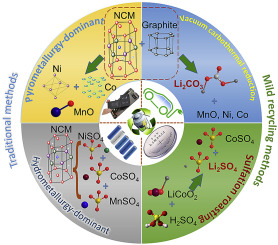Journal of Cleaner Production ( IF 9.7 ) Pub Date : 2019-04-24 , DOI: 10.1016/j.jclepro.2019.04.304 Chunwei Liu , Jiao Lin , Hongbin Cao , Yi Zhang , Zhi Sun

|
Due to the rapid expanding of plug-in hybrid electric vehicles (PHEVs), hybrid electric vehicles (HEVs) and electric vehicles (EVs), the projectfed demand for lithium-ion batteries (LIBs) is huge and might result in supply risks for natural lithium-containing reserves. After the service life, spent LIBs continuously accumulate in the market, and they are excellent secondary resources for lithium recovery. To alleviate resource shortage and to decrease potential environmental pollution caused by improper solid waste disposal, recycling of spent LIBs is motivated world widely in recent years. Previous studies have usually focused on the recovery of cobalt and nickel, which create high economic benefit. Recovery of lithium, however, has not been highlighted. In this article, state-of-the-art on spent LIBs recycling is discussed with emphasis on lithium recovery. In addition to understanding underlying mechanisms and physiochemistry features of various recycling methods, the possibility for industrial realization of each method is also evaluated. The complex processing steps limit the industrial implementation of hydrometallurgy-dominant methods, which usually reclaim lithium in the last step, resulting in a poor recovery efficiency of lithium. The pyrometallurgy-dominant approach is readily to scale up but lithium is lost in the slag phase. Therefore, the mild recycling (cleaner production) methods are recommended for future study since they take advantages of traditional pyrometallurgy and hydrometallurgy, and could decrease treatment temperature as well as acid/alkaline usage.
中文翻译:

鉴于锂的回收,对废旧的锂离子电池进行回收:一项严格的审查
由于插电式混合动力汽车(PHEV),混合动力汽车(HEV)和电动汽车(EV)的迅速发展,锂离子电池(LIB)的预计需求巨大,可能会导致天然锂的供应风险含锂储量。使用寿命结束后,用完的LIB会在市场上不断积累,它们是锂回收的极佳辅助资源。为了减轻资源短缺并减少由于不适当的固体废物处理而造成的潜在环境污染,近几年来,世界范围内广泛地推动了废旧LIB的回收利用。以前的研究通常集中在钴和镍的回收上,这创造了很高的经济效益。然而,锂的回收尚未被强调。在本文中,讨论了废旧LIB回收的最新技术,重点是锂的回收。除了了解各种回收方法的潜在机理和理化特性外,还评估了每种方法在工业上实现的可能性。复杂的加工步骤限制了湿法冶金方法的工业实施,该方法通常在最后一步回收锂,导致锂的回收效率差。火法冶金法很容易扩大规模,但锂在炉渣相中损失。因此,建议采用温和的回收利用(清洁生产)方法,因为它们利用了传统的火法冶金和湿法冶金的优势,并且可以降低处理温度以及酸/碱的使用量。除了了解各种回收方法的潜在机理和理化特性外,还评估了每种方法在工业上实现的可能性。复杂的加工步骤限制了湿法冶金方法的工业实施,该方法通常在最后一步回收锂,导致锂的回收效率差。火法冶金法很容易扩大规模,但锂在炉渣相中损失。因此,建议采用温和的回收利用(清洁生产)方法,因为它们利用了传统的火法冶金和湿法冶金的优势,并且可以降低处理温度以及酸/碱的使用量。除了了解各种回收方法的潜在机理和理化特性外,还评估了每种方法在工业上实现的可能性。复杂的加工步骤限制了湿法冶金方法的工业实施,该方法通常在最后一步回收锂,导致锂的回收效率差。火法冶金法很容易扩大规模,但是锂在炉渣相中损失了。因此,建议采用温和的回收利用(清洁生产)方法,因为它们利用了传统的火法冶金和湿法冶金的优势,并且可以降低处理温度以及酸/碱的使用量。还评估了每种方法在工业上的实现可能性。复杂的加工步骤限制了湿法冶金方法的工业实施,该方法通常在最后一步回收锂,导致锂的回收效率很低。火法冶金法很容易扩大规模,但锂在炉渣相中损失。因此,建议采用温和的回收利用(清洁生产)方法,因为它们利用了传统的火法冶金和湿法冶金的优势,并且可以降低处理温度以及酸/碱的使用量。还评估了每种方法在工业上的实现可能性。复杂的加工步骤限制了湿法冶金方法的工业实施,该方法通常在最后一步回收锂,导致锂的回收效率差。火法冶金法很容易扩大规模,但锂在炉渣相中损失。因此,建议采用温和的回收利用(清洁生产)方法,因为它们利用了传统的火法冶金和湿法冶金的优势,并且可以降低处理温度以及酸/碱的使用量。火法冶金法很容易扩大规模,但锂在炉渣相中损失。因此,建议采用温和的回收利用(清洁生产)方法,因为它们利用了传统的火法冶金和湿法冶金的优势,并且可以降低处理温度以及酸/碱的使用量。火法冶金法很容易扩大规模,但是锂在炉渣相中损失了。因此,建议采用温和的回收利用(清洁生产)方法,因为它们利用了传统的火法冶金和湿法冶金的优势,并且可以降低处理温度以及酸/碱的使用量。











































 京公网安备 11010802027423号
京公网安备 11010802027423号